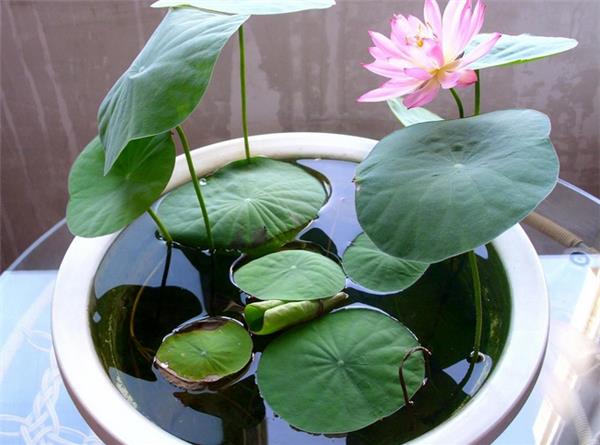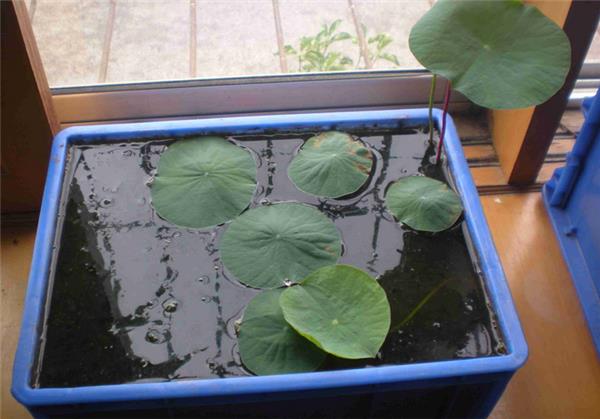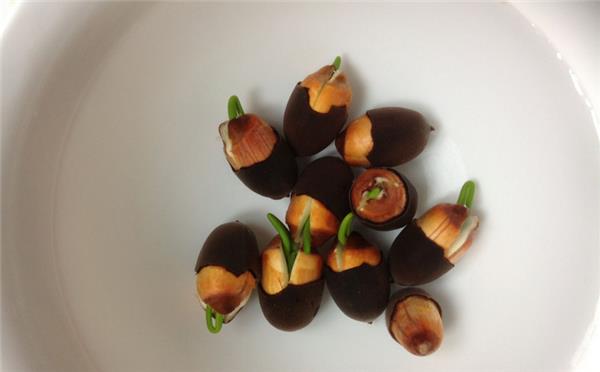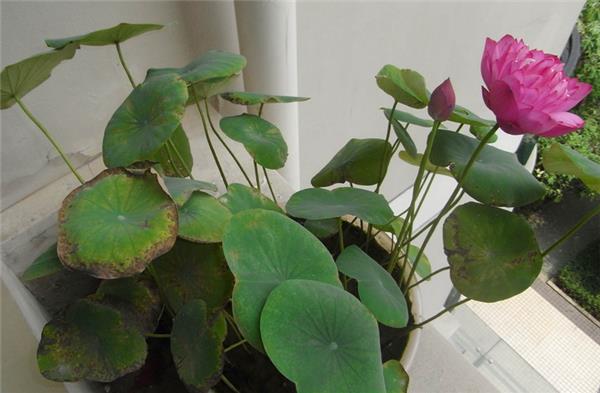Introduction and cultivation skills of bowl lotus how to cultivate graceful bowl lotus
The bowl lotus, as its name implies, is the lotus planted in the bowl. Also known as potted lotus and potted lotus, they are lotus flowers planted in bowls, specially for Chen on several tables in the room to beautify the living environment. Now let's take a look at the knowledge of bowl lotus.

First, the introduction of bowl lotus
The bowl lotus is a perennial aquatic plant. The underground stem is deeply buried in the sediment. It blossoms in summer and flowers stand alone. The seed has a hard impervious seed coat that can be kept from decay for thousands of years. Like to have plenty of sunshine, but can't bear shade. Like heat, the suitable temperature for growth is 20-30 ℃, and the growth stagnates when the temperature is lower than 15 ℃. Like wet and afraid of dry, like relatively stable still water. It is appropriate to use rich clay rich in organic matter. The suitable pH value is 6.5.

Second, the cultivation techniques of bowl lotus.
To cultivate bowl lotus, it is appropriate to choose excellent varieties whose flower diameter is less than 7~8cm, plant height is about 20~25cm, and standing leaves do not exceed 15cm, such as "Jiaolong", "Walian", "Snow White", "drunken Cup" and so on. The cultivation container should not be too small, and the container is too small to blossom. The caliber of household vegetable bowls is generally only 15cm, which is too small, so it is best to use a small round cylinder with a caliber of 25cm and about 20cm. Fertile river pond mud is the most ideal soil for cultivation. Planting before and after the Qingming Festival, first cover a thick layer of humus soil with 3~4cm at the bottom of the cylinder, and mix in some rotten cake fertilizer liquid. Then pad into the culture soil (above need to leave 5~6cm along the mouth for water storage) and a small amount of water, adjust to a thin paste, and then put the top bud of the small lotus root down, oblique along the edge of the tank into the mud, so that the tail section is warped up, slightly exposed to the mud surface, and placed in the sunny place to receive sunlight for 2-3 days to make the mud shrink, fix the lotus root, raise the soil temperature and facilitate sprouting. At this time, add a small amount of water, wait for the floating leaves to grow, and then slightly raise the water level, until the vertical leaves grow out, gradually fill the tank with the elongation of the petiole, and then add some water every day. During the growth of lotus, there is no need to apply fertilizer. Fertilizing too much will lead to fertilizer damage. The bowl lotus is delicate and vulnerable to freezing. At the beginning of winter, you should move the bowl into the sunny place indoors and add a small amount of water every week. Wait until the Qingming Festival next year to turn the basin, take out the lotus root and replant it.

Third, the culture method of bowl lotus
1. Selection of basin
Although the name is called bowl lotus, but if you use vegetable bowl culture, it is too small, too shallow. The nutrient soil in the bowl is too shallow to make the plant get sufficient nutrients; it is too small to accommodate the stretched fibrous roots, and it will not grow well. A suitable size is to ensure that the diameter of the container is about 25~87.5cm. The depth is about 20~62.5cm. Make sure the soil around the 37.5cm is deep enough for the roots to grow fully.
two。 Soil selection
Bowl lotus requires pond mud or paddy field mud rich in humus to be used as cultivation soil, and do not use industrial pollution soil. The viscosity of yellow mud is high, and the usage should be appropriate, too sticky will affect the elongation of lotus root whip and the expansion of lotus root; sandy soil is loose and not sticky enough, and is easy to be damaged by wind damage, which hinders the growth of root system. Generally, it is appropriate to mix yellow mud and sandy soil at the ratio of 7:3. If there is no sandy soil, yellow sand can be added, but the proportion is slightly smaller. In the suburbs of the city, the garden soil of the vegetable field can be selected directly, and the dormitory soil in which the spring potted flowers change pots can also be used in the city, plus half of the yellow mud as the cultivation soil.
3. Seed planting
Preparation: bowl lotus seeds, files, a container basin, sand. You can buy a little sand from the aquarium shop, sprinkle the sand in and spread it on the mud. The sand was sprinkled several times. Sprinkle again, wait for the water to precipitate and sprinkle again until the whole jar is scattered evenly. With the sand, the water soon cleared. Then change the water, you can also raise a few small fish inside, fish can eat the worms in the water, feces can be fat flowers, but also can watch, kill a few birds with one stone. The seed coat of bowl lotus is very thick, in order to germinate smoothly, simple treatment is needed. First of all, please distinguish between the two ends of the bowl lotus seed, one end is a small bulge, one end is a small concave point, to deal with the concave end. Grind off the seed coat on the cement floor

4. Lotus species
Lotus seeds need to be broken before planting, and the seed coat needs to be opened at one end of the sunken buttocks. Can be used to grind the skin on the cement floor or use pliers to grind the seed coat off the buttocks. Do not grind the seed coat until it has been worn through. Just see the dark brown embryo inside, and don't hurt the seed embryo inside. After breaking the skin, soak the seeds in water, which can be exposed to the sun. At the same time, pay attention to the replenishment of water. Water needs to be changed twice a day. When the temperature is above 20 ℃, it can sprout in about 3 days. After budding, the seed coat can be peeled off again for better absorption of water. After sending out the root, move it to the container for planting.
5. Container
A suitable size is to ensure that the diameter of the container is about 25~35cm. The depth is about 20~25cm. Make sure the soil around the 15cm is deep enough for the roots to grow fully.
6. Sunshine
Be sure to give the lotus plenty of sunshine. Flower growers should not only pay attention to the bowl lotus indoor decoration environment and appreciation, keep it indoors for a long time so that it can not see the sun, forget that it is a plant that loves plenty of sunshine, only when the pot soil is warm, can it grow rapidly.
7. Water quantity
The amount of water varies from stage to stage. When the bowl lotus is first planted, there should not be much water, which will lower the temperature, not conducive to the rooting and development of seedlings, and affect its respiration and ventilation, and even cause rotten roots. When the leaves of the plant grow up, the bowl needs to be filled with clear water gradually in order to meet the needs of photosynthesis when the leaves float on the water surface. Otherwise, the leaf edge will be scorched and yellowed.
8. Fertilizer application
Bowl lotus likes fertilizer, but if it is lack of fertilizer, it will take root and grow leaves slowly and lack vitality. Therefore, before planting, a small amount of cooked cake fertilizer liquid or bean bran and peanut bran should be mixed into the pot soil as base fertilizer. However, although the bowl lotus is a fertilizer-loving plant, it should not be fertilized excessively, especially because the bowl lotus container is small, the plant is small, and the amount of fertilizer needed is also small. If more fertilizer is applied, there will be the phenomenon of light and long leaves not blooming. If it is more serious, it can also wither the plant. If excessive fertilization is found, it is necessary to change the water frequently to float away part of the fertilizer liquid and desalinate it.
The above is the knowledge of bowl lotus. I hope I can help you.
The water needs to be changed twice a day. When the temperature is above 20 ℃, it can sprout in about 3 days. After budding, the seed coat can be peeled off again for better absorption of water. After sending out the root, move it to the container for planting.
5. Container
A suitable size is to ensure that the diameter of the container is about 25~35cm. The depth is about 20~25cm. Make sure the soil around the 15cm is deep enough for the roots to grow fully.
6. Sunshine
Be sure to give the lotus plenty of sunshine. Flower growers should not only pay attention to the bowl lotus indoor decoration environment and appreciation, keep it indoors for a long time so that it can not see the sun, forget that it is a plant that loves plenty of sunshine, only when the pot soil is warm, can it grow rapidly.
7. Water quantity
The amount of water varies from stage to stage. When the bowl lotus is first planted, there should not be much water, which will lower the temperature, not conducive to the rooting and development of seedlings, and affect its respiration and ventilation, and even cause rotten roots. When the leaves of the plant grow up, the bowl needs to be filled with clear water gradually in order to meet the needs of photosynthesis when the leaves float on the water surface. Otherwise, the leaf edge will be scorched and yellowed.
8. Fertilizer application
Bowl lotus likes fertilizer, but if it is lack of fertilizer, it will take root and grow leaves slowly and lack vitality. Therefore, before planting, a small amount of cooked cake fertilizer liquid or bean bran and peanut bran should be mixed into the pot soil as base fertilizer. However, although the bowl lotus is a fertilizer-loving plant, it should not be fertilized excessively, especially because the bowl lotus container is small, the plant is small, and the amount of fertilizer needed is also small. If more fertilizer is applied, there will be the phenomenon of light and long leaves not blooming. If it is more serious, it can also wither the plant. If excessive fertilization is found, it is necessary to change the water frequently to float away part of the fertilizer liquid and desalinate it.
The above is the knowledge of bowl lotus. I hope I can help you.
Related
- Wuhan Hospital Iron Tree Blooming Result Was Instantly Frightened by the Gardener Master
- Which variety of camellia is the most fragrant and best? Which one do you like best?
- What is the small blue coat, the breeding methods and matters needing attention of the succulent plant
- Dormancy time and maintenance management of succulent plants during dormancy
- Minas succulent how to raise, Minas succulent plant pictures
- What are the varieties of winter succulent plants
- How to raise succulent plants in twelve rolls? let's take a look at some experience of breeding twelve rolls.
- Attention should be paid to water control for succulent plants during dormant period (winter and summer)
- Watering experience of twelve rolls of succulent plants
- Techniques for fertilizing succulent plants. An article will let you know how to fertilize succulent plants.



